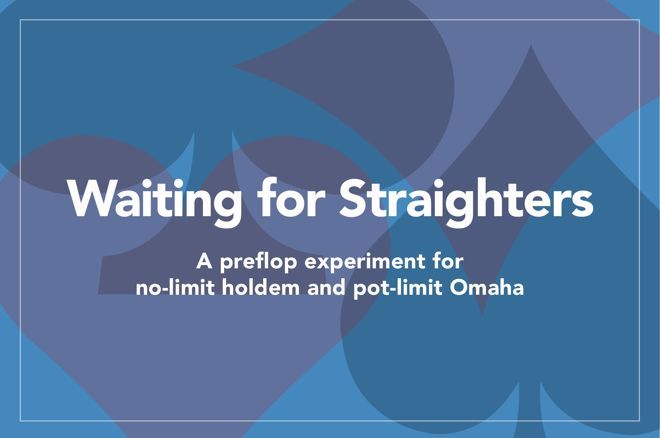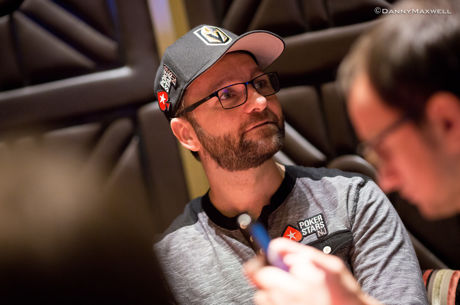Tommy Angelo Presents: Waiting for Straighters, Part II - No-Limit Hold'em

Introduction to Episode 2
In hold'em, a straighter is a hand that can flop a straight. 6-2 is a straighter. 7-2 isn't. In pot-limit Omaha, a straighter is a hand with no pairs, no aces, and no more than two gaps. J-9-8-6 has two gaps, so that's a straighter. J-9-8-5 has three gaps, so it's not.
Waiting for straighters does not mean wait until you get a straighter and then play it. It means wait for a straighter, at least, and then maybe play it. In other words, fold the non-straighters. That's the gist of this article.
This episode is about waiting for straighters in no-limit hold'em.
PART II — APPLICATION
Waiting for straighters means different things to different players depending on where they fall on the loose-tight spectrum and the aggressive-passive spectrum. To a loose-aggressive player, WFS could mean folding J♠6♠, J♠5♠, J♠4♠, J♠3♠, and J♠2♠ in the early seats, and waiting for at least J♠7♠ to open with. Whereas to a tight-aggressive player, WFS could mean folding A♠9♠, A♠8♠, A♠7♠, and A♠6♠. And to a tight-passive player, WFS could mean loosening up and playing J♠7♠ on the button instead of folding it.
Waiting for straighters can strengthen your game strategically, and mentally. It can make you more wealthy, and less unhappy.
WFS and Being Last to Act
"Acting last is like taking a drink of water. We don't have to understand why it's good for us to know that it is. And the benefits are unaffected by our understanding of them."
"There are only two postflop positions: last to act, and other."
~Elements of Poker
Being last to act is about losing the least when you're beat, and winning the most when you're not. Only as last to act can you check behind. Only as last to act can you bet when checked to. Only as last to act can you be bet into when you have a monster. Only as last to act can you plan the hand as last to act. This is why money flows to the button.
Waiting for straighters does not mean playing straighters out of position just because you have a straighter. Waiting for straighters is two kinds of waiting. Waiting for cards. And waiting for last to act.
Reminder: It's a short wait from the blinds to the button.
The button makes all hands better, but not equally. Drawing hands gain the most. The difference in value between 9-8 in the small blind and 9-8 on the button is greater than the difference in value between A-A in the small blind and A-A on the button. I happen to think it's a lot greater. I fold 9-8 (suited or not) from the blinds and early seats. And I play 9-8 (suited or not) on the button (if the bet-size to stack-size ratios are right).
You have A♣Q♣ in the big blind. It's folded to the button. He gives lots of action. He opens to 5x. The small blind folds and you three-bet. The button calls. The flop is J♣3♣2♦.
Nice flop, right?
Please take a moment to recall the tinge of tension you feel on each street, in your core, as first to act. I'll wait.
Now compare that discomfort to the luxurious feeling of flopping the nut flush draw with overcards, and acting last. The reason you feel safe and profitable is because you get to see what they do first, on the flop, on the turn, and on the river. You'll never have it so good with nothing.
If you've played a lot of poker, you subconsciously know that every time you're in a heads-up pot, you are always either in the very best position in poker, or the very worst. You either have the advantage, or you don't, on every street.
Here's my approach to playing NLHE and PLO. I know from experience that if I act last on way more streets than the opposition, I'll make enough money to live on. So I fold a lot preflop from the blinds and the early seats, and after the flop, I give up sooner than most when I'm first to act and I whiff. The result is that I am last to act on about 80 percent of the streets I play. It's such a huge edge that sometimes it feels unfair.
I take the same approach with straighters. My objective is lopsidedness. I want to start with straighters more often than my opponents do, and I accomplish this by folding non-straighters more often than they do.
Being last to act is a power that should be abused, right up to the point when it shouldn't. Pro players swing like a pendulum around that point. We tighten up, and that generates power that we then abuse appropriately and profitably, for a while, until we abuse it too much, which causes losing, and the pain of losing makes us tighten back up, which turns the power back on, and the winning resumes.
The cycle I just described is a fractal. It can play out over a span of months, weeks, or hours. I have used WFS to end the power cycle permanently on all time scales. WFS keeps me from over-abusing the power, and poof, no more pendulum.
Strategic Merits of WFS in No-Limit Hold'em
The crux: With a straighter, you can clandestinely draw to a hand that will beat hands that will pay off.
Let's run some cards. The effective stacks sizes are 200 big blinds.
A loose player opens to 4x under the gun, and it's folded to you on the button. You have K♥8♥, and you fold.
That fold is what it means to wait for a straighter.
One orbit later, the same player opens again and everyone folds again. This time you have K♥10♥ on the button. You three-bet, the blinds fold, and the opener calls.
The flop is J♠7♦2♣. Your opponent checks, you bet, and when he calls, you get a sense that he likes his hand.
The turn is the 9♥, making the board J♠7♦2♣9♥.
You have K-10, so now you need a queen or an 8 to make a straight.
He checks, and you check behind, and…
This is when you genuflect to the poker gods in gratitude for this divine gift: a free card that could win you a big pot. And this free card was actually free. All you did was c-bet a dry flop, a standard play for you, so those funds were already appropriated.
Let's review the-hand-so-far, and predict the future. With a scattered flop, your opponent check-called your bet on the flop. Some percentage of the time, he will have a very good hand. It doesn't matter if he's a maniac or a nit. A set is a set. Two pair is two pair. Those are hands that any opponent could have when they call your c-bet and check the turn. And when they decide to play it slow like that, they will have their finger on the trigger, ready to fire into you on the river.
And most of the time, you'll fold gracefully when they bet. That's the usual ending to this traditional dance. But sometimes, your straight gets there, and that's when chips fly — into your stack. Besides cracking made hands, you make money when they improve to two pair on the river, and when they value bet with one pair, and when they bluff the river because you checked the turn.
And when you raise the river, you'll have the nuts, or close.
With K-8, none of those happy endings can happen.
Cracking Sets and Two Pair with Buried Straights
If you have J-6, and you don't have a flush draw, your hopes for winning a major pot by cracking a set is nearly nil. First you have to make a full house by catching two jacks and a six or two sixes and a jack. And when you do manage to fill up, about half the time the player with a set will have a higher full house. And those losses can be soul crushers.
With J-7, viable set-cracking opportunities arise. You can flop a straight, flop an open-ender, flop a double-gutter, and flop a gutshot. And because you'll be using both hole cards, your straights will be buried. They'll be hard to spot, and hard to believe in.
Also with a straighter, you can flop a pair and a straight draw — like when you have 9-5 and the flop is 9-7-6 — or you can make a hand like that on the turn. And whenever you make a straight on the river against a set or two pair, your soul is safe. You win the pot every time.
Straights are better than flushes for cracking sets because when three hearts hit the board, any hand with two hearts just made a flush, and the holder of the set will see the danger, and might proceed cautiously. Timidity in these situations could be bad strategy for that player in the long run, but on a hand-by-hand basis, the "scared" player will in fact get away cheap when you have the flush. But when that same player flops a set and gets beat by a buried straight on an unpaired rainbow board, he gets stacked, because that's how the poker world turns.
Squeeze Plays
I'm in the big blind and a player with a wide opening range opens for his standard 3x. Two players call, and the action is on me. I believe the opener will fold two-thirds of his range if I three-bet. And I believe both callers will fold nearly always. I look at my cards, 9♥3♣, and I try to act like someone who just saw A♠A♦, and I raise.
That's how I was playing no-limit in 1998. And I was making good money. (Mostly because the games were extra soft.) Then for 12 years, my squeezing range gradually narrowed, and I think I know why. It's because of the times the opener forgets to fold (as I had scripted). And then the dealer puts out a flop, and I've got no pair, no draw, and no high cards, and what am I supposed to do now? Just check-fold every time? Like hell I am! I came in swinging and I'll keep swinging! At least for a street or two (or three if absolutely necessary). And when the opponent continues to not fold I'm like, How the fudge did I get into this mess?
And on the drive home, the occasional ray of wisdom shines through: Would I go broke if I were to expunge this pattern of pain from my game? Maybe from now on I should wait until I have something halfway decent before I go charging into major conflicts out of position.
What I'm suggesting is that if you are playing in a full, live, cash game, and one of your cards is, say, a queen, that you don't squeeze unless the other card is an A, K, J, T, 9, or 8. To be clear, I'm not saying you should squeeze because you have a straighter. I'm saying you should refrain from squeezing because you don't. Because sometimes they forget to fold, and then you'll have a flop, turn, and river to play, first to act, against a player who likes his hand. And that's a fine time to have something halfway decent, every time.
And by increasing your preflop folding rate, your squeezes and c-bets will gain heft and believability, which translates to increased fold equity.
Limped Pots in No-Limit Hold'em
Playing $2/$5 NLHE, I'm on the button and three players limp. I lift the corners to see 6♥2♥. I have composed concertos with this hand. The flop is K♠4♦3♣. I need a 5 for the second nuts. Two thoughts come to mind:
- Poker loves me.
- Just in case, I should tune my Spidey sense to spot a 6-7, the only hand that can hurt me.
As often happens in multi-way limped pots, everyone checked the flop. And now it was on me, to either bet or check. Nobody at the table knew this, but I had no choice. I had to check. That's because I was following a script. 6♥2♥ is the worst hand I ever play, and this is the only way I ever play it: limp in, multi-way, on the button, and then, if the opportunity presents, I check behind on the flop with a slowly tapping pinky finger. (Unless I flop two pair or better, in which case, let's gambol!)
At this point in the script — after I check the flop and before the turn card is dealt — the pot is always puny, everyone will know six of their seven cards before they bet again, and no one knows what anyone has. So we're all on equal footing.
Except for one stupendously huge thing.
There are two rounds of betting to go, and only one person gets to go last, and that person is me. What a dandy time to have a straight draw that could cause major stack damage to bad players holding good hands. And it only cost me five bucks to get here.
I'm happy to play 6♥2♥ on the button, or 7♥3♥, but never 7♥2♥. This was a tough decision because there are times when I could play any hand with positive expectation. But I made a choice. To always throw some hands away. I raised my worst-hand-ever-play bar all the way up to 6♥2♥. And now I always have a chance at a bingo.
A Pair Plus a Draw at NLHE
A two-way hand is a hand that already has showdown value (such as one pair in hold'em or a set in Omaha) and can also improve to a straight or a flush. Two-way hands create favorable gaming conditions. The thinking is: I might have the best hand now, but if I don't, I have a backup plan. And if my pair is good on the river, I might earn extra money with a value bet, or by picking off a bluff.
But if all you have is a draw, and you miss, your only options are to fold (boring) or to bluff (needlessly risky). Two-way hands are safer and funner and win more pots.
Two-way hands at hold'em can be hard to read because first the villain is playing the hand like he has a pair, because he does, and then a flush card comes on the turn or river, and now he bets or raises like someone who made a flush, because he did. The stories don't match. Something smells fishy. And you've got a pocket overpair. So you call a big bet and lose.
I'm not saying you made a bad call. I'm saying it's tough to play against two-way hands, which is why you should want to have them. With JT, J9, J8, and J7, you can flop a two-way hand; for example, you have J7 and the flop is J-9-8. With J6, J5, J4, J3, and J2, you can't.
A Pair with a Backdoor Straight Draw at NLHE
You have A-6 and the villain has K-9. The flop is 9-6-2. You are behind, and you can take the lead by catching an ace or a 6. That's five outs.
If you have 8-6 instead of A-6, the 9-6-2 flop gives you a covert backup plan to go with your pair. If a 7 comes on the turn, you now have an open-ender, and a 10 or 5 on the turn gives you a gutshot. That's 12 additional cards that improve your hand on the turn, because you started with a straighter.
The next two episodes of Waiting for Straighters are about pot-limit Omaha, starting with my own discoveries and revelations, followed by a deep dive into how and why to WFS at PLO. Waiting for Straighters is available in ebook and audiobook at all the usual places.
- Part I - Discovery (Episode 1)
- Part II - Pot-Limit Omaha (Episode 3)
- Part II - Strategy Merits in PLO (Episode 4)
- Part III - Taming Tilt and Plugging Leaks (Episode 5)

World-class coach and author Tommy Angelo is now offering poker pain relief to everyone. You can schedule a call to talk to Tommy about bad betting, bad quitting, bad tempers, or whatever else is hurting your game. Just go to tommyangelo.com. Angelo's first book, Elements of Poker, was called "the seminal poker text of the 21st century" by The London Times, and it has revolutionized the way serious players approach the game.
In this Series
- 1 Tommy Angelo Presents: Waiting for Straighters, Part I - Discovery
- 2 Tommy Angelo Presents: Waiting for Straighters, Part II - No-Limit Hold'em
- 3 Tommy Angelo Presents: Waiting for Straighters, Part II - Pot-Limit Omaha
- 4 Tommy Angelo Presents: Waiting for Straighters, Part II - Strategy Merits in PLO
- 5 Tommy Angelo Presents: Waiting for Straighters, Part III - Taming Tilt and Plugging Leaks









